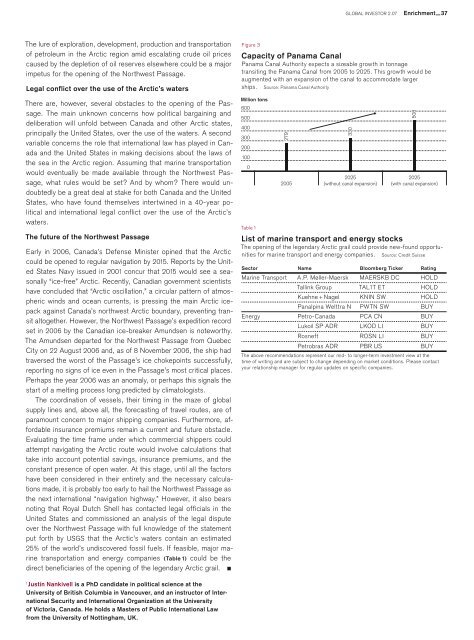Create successful ePaper yourself
Turn your PDF publications into a flip-book with our unique Google optimized e-Paper software.
GLOBAL INVESTOR 2.07 Enrichment — 37<br />
The lure of exploration, development, production and transportation<br />
of petroleum in the Arctic region amid escalating crude oil prices<br />
caused by the depletion of oil reserves elsewhere could be a major<br />
impetus for the opening of the Northwest Passage.<br />
Legal conflict over the use of the Arctic’s waters<br />
There are, however, several obstacles to the opening of the Passage.<br />
The main unknown concerns how political bargaining and<br />
deliberation will unfold between Canada and other Arctic states,<br />
principally the United States, over the use of the waters. A second<br />
variable concerns the role that international law has played in Canada<br />
and the United States in making decisions about the laws of<br />
the sea in the Arctic region. Assuming that marine transportation<br />
would eventually be made available through the Northwest Passage,<br />
what rules would be set? And by whom? There would undoubtedly<br />
be a great deal at stake for both Canada and the United<br />
States, who have found themselves intertwined in a 40-year political<br />
and international legal conflict over the use of the Arctic’s<br />
waters.<br />
The future of the Northwest Passage<br />
Early in 2006, Canada’s Defense Minister opined that the Arctic<br />
could be opened to regular navigation by 2015. Reports by the United<br />
States Navy issued in 2001 concur that 2015 would see a seasonally<br />
“ice-free” Arctic. Recently, Canadian government scientists<br />
have concluded that “Arctic oscillation,” a circular pattern of atmospheric<br />
winds and ocean currents, is pressing the main Arctic icepack<br />
against Canada’s northwest Arctic boundary, preventing transit<br />
altogether. However, the Northwest Passage’s expedition record<br />
set in 2006 by the Canadian ice-breaker Amundsen is noteworthy.<br />
The Amundsen departed for the Northwest Passage from Quebec<br />
City on 22 August 2006 and, as of 8 November 2006, the ship had<br />
traversed the worst of the Passage’s ice chokepoints successfully,<br />
reporting no signs of ice even in the Passage’s most critical places.<br />
Perhaps the year 2006 was an anomaly, or perhaps this signals the<br />
start of a melting process long predicted by climatologists.<br />
The coordination of vessels, their timing in the maze of <strong>global</strong><br />
supply lines and, above all, the forecasting of travel routes, are of<br />
paramount concern to major shipping companies. Furthermore, affordable<br />
insurance premiums remain a current and future obstacle.<br />
Evaluating the time frame under which commercial shippers could<br />
attempt navigating the Arctic route would involve calculations that<br />
take into account potential savings, insurance premiums, and the<br />
constant presence of open water. At this stage, until all the factors<br />
have been considered in their entirety and the necessary calculations<br />
made, it is probably too early to hail the Northwest Passage as<br />
the next international “navigation highway.” However, it also bears<br />
noting that Royal Dutch Shell has contacted legal officials in the<br />
United States and commissioned an analysis of the legal dispute<br />
over the Northwest Passage with full knowledge of the statement<br />
put forth by USGS that the Arctic’s waters contain an estimated<br />
25% of the world’s undiscovered fossil fuels. If feasible, major marine<br />
transportation and energy companies (Table 1) could be the<br />
direct beneficiaries of the opening of the legendary Arctic grail. <br />
Figure 3<br />
Capacity of Panama Canal<br />
Panama Canal Authority expects a sizeable growth in tonnage<br />
transiting the Panama Canal from 2005 to 2025. This growth would be<br />
augmented with an expansion of the canal to accommodate larger<br />
ships. Source: Panama Canal Authority<br />
Million tons<br />
600<br />
500<br />
400<br />
300<br />
200<br />
100<br />
0<br />
Table 1<br />
279<br />
2005<br />
2025<br />
(without canal expansion)<br />
2025<br />
(with canal expansion)<br />
List of marine transport and energy stocks<br />
The opening of the legendary Arctic grail could provide new-found opportunities<br />
for marine transport and energy companies. Source: Credit Suisse<br />
Sector Name Bloomberg Ticker Rating<br />
Marine Transport A.P. Møller-Maersk MAERSKB DC HOLD<br />
Tallink Group TAL1T ET HOLD<br />
Kuehne + Nagel KNIN SW HOLD<br />
Panalpina Welttra N PWTN SW BUY<br />
Energy Petro-Canada PCA CN BUY<br />
Lukoil SP ADR LKOD LI BUY<br />
Rosneft ROSN LI BUY<br />
Petrobras ADR PBR US BUY<br />
The above recommendations represent our mid- to longer-term investment view at the<br />
time of writing and are subject to change depending on market conditions. Please contact<br />
your relationship manager for regular updates on specific companies.<br />
330<br />
508<br />
1<br />
Justin Nankivell is a PhD candidate in political science at the<br />
University of British Columbia in Vancouver, and an instructor of International<br />
Security and International Organization at the University<br />
of Victoria, Canada. He holds a Masters of Public International Law<br />
from the University of Nottingham, UK.

















